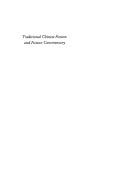| Listing 1 - 5 of 5 |
Sort by
|

ISBN: 0804727201 Year: 1997 Publisher: Stanford (Calif.): Stanford university press
Abstract | Keywords | Export | Availability | Bookmark
 Loading...
Loading...Choose an application
- Reference Manager
- EndNote
- RefWorks (Direct export to RefWorks)
S16/0160 --- S16/0195 --- S16/0190 --- Chinese fiction --- -Chinese fiction --- -Chinese literature --- China: Literature and theatrical art--General works on traditional literature --- China: Literature and theatrical art--Thematic studies --- China: Literature and theatrical art--Literary criticism --- Book reviews --- History and criticism --- Book reviews. --- History and criticism. --- -China: Literature and theatrical art--General works on traditional literature --- Chinese literature
Book
ISBN: 0691067538 1322019126 9781400860470 1400860474 9780691067537 0691606714 9780691606712 Year: 2014 Publisher: Princeton, NJ
Abstract | Keywords | Export | Availability | Bookmark
 Loading...
Loading...Choose an application
- Reference Manager
- EndNote
- RefWorks (Direct export to RefWorks)
Fiction criticism has a long and influential history in pre-modern China, where critics would read and reread certain novels with a concentration and fervor far exceeding that which most Western critics give to individual works. This volume, a source book for the study of traditional Chinese fiction criticism from the late sixteenth to the early twentieth centuries, presents translations of writings taken from the commentary editions of six of the most important novels of pre-modern China. These translations consist mainly of tu-fa, or "how-to-read" essays, which demonstrate sensitivity and depth of analysis both in the treatment of general problems concerning the reading of any work of fiction and in more focused discussions of particular compositional details in individual novels.The translations were produced by pioneers in the study of this form of fiction criticism in the West: Shuen-fu Lin, Andrew H. Plaks, David T. Roy, John C. Y. Wang, and Anthony C. Yu. Four introductory essays by Andrew H. Plaks and the editor address the historical background for this type of criticism, its early development, its formal features, recurrent terminology, and major interpretive strategies. A goal of this volume is to aid in the rediscovery of this traditional Chinese poetics of fiction and help eliminate some of the distortions encountered in the past by the imposition of Western theories of fiction on Chinese novels.Originally published in 1990.The Princeton Legacy Library uses the latest print-on-demand technology to again make available previously out-of-print books from the distinguished backlist of Princeton University Press. These editions preserve the original texts of these important books while presenting them in durable paperback and hardcover editions. The goal of the Princeton Legacy Library is to vastly increase access to the rich scholarly heritage found in the thousands of books published by Princeton University Press since its founding in 1905.
S16/0400 --- Chinese fiction --- -Chinese literature --- China: Literature and theatrical art--Traditional novels: studies --- -China: Literature and theatrical art--Traditional novels: studies --- History and criticism --- History and criticism. --- Chinese fiction -- History and criticism.
Book
ISBN: 9789004463394 9789004461925 9004463399 9004461922 Year: 2021 Publisher: Leiden Boston
Abstract | Keywords | Export | Availability | Bookmark
 Loading...
Loading...Choose an application
- Reference Manager
- EndNote
- RefWorks (Direct export to RefWorks)
What was the most influential mass medium in China before the internet? Jingju (Peking opera)! Although its actors were commonly thought to have been illiterate, written and other inscripted versions of plays became more and more important and varied. This book shows how increasing textualization and the resulting fixation of a performance tradition that once privileged improvisation changed the genre. It traces, from Jingju 's birth in the 19th century to the present, how texts were used for the production and consumption of this important performance genre and the changes in the concepts of authorship, copyright, and performance rights that took place during the process. The state's desire to police what was performed is shown to have been a major factor in these changes. The scope and coverage of the book is already unprecedented, but it is also supplemented by an additional chapter (on where the plays were performed, who performed them, and who went to see them) available for download online.
Book
ISBN: 9004463399 Year: 2021 Publisher: Leiden, Netherlands ; Boston, Massachusetts : Brill,
Abstract | Keywords | Export | Availability | Bookmark
 Loading...
Loading...Choose an application
- Reference Manager
- EndNote
- RefWorks (Direct export to RefWorks)
What was the most influential mass medium in China before the internet? Jingju (Peking opera)! Although its actors were commonly thought to have been illiterate, written and other inscripted versions of plays became more and more important and varied. This book shows how increasing textualization and the resulting fixation of a performance tradition that once privileged improvisation changed the genre. It traces, from Jingju 's birth in the 19th century to the present, how texts were used for the production and consumption of this important performance genre and the changes in the concepts of authorship, copyright, and performance rights that took place during the process. The state's desire to police what was performed is shown to have been a major factor in these changes. The scope and coverage of the book is already unprecedented, but it is also supplemented by an additional chapter (on where the plays were performed, who performed them, and who went to see them) available for download online.
Book
Year: 1997 Publisher: Stanford, Calif. Stanford University Press
Abstract | Keywords | Export | Availability | Bookmark
 Loading...
Loading...Choose an application
- Reference Manager
- EndNote
- RefWorks (Direct export to RefWorks)
| Listing 1 - 5 of 5 |
Sort by
|

 Search
Search Feedback
Feedback About UniCat
About UniCat  Help
Help News
News